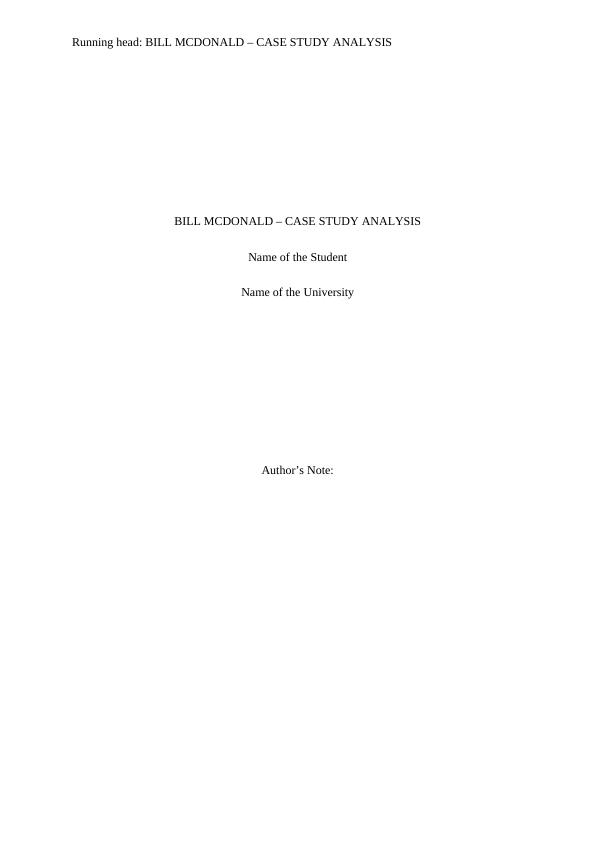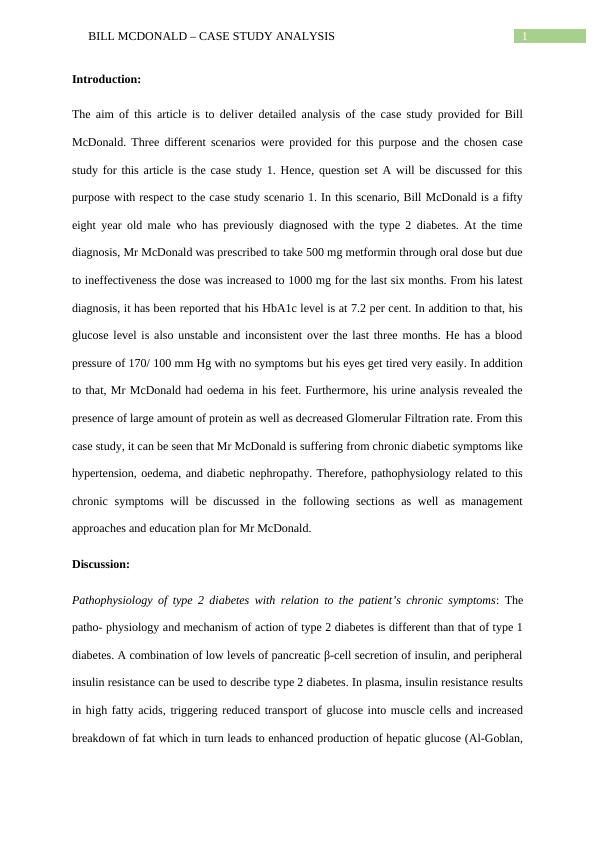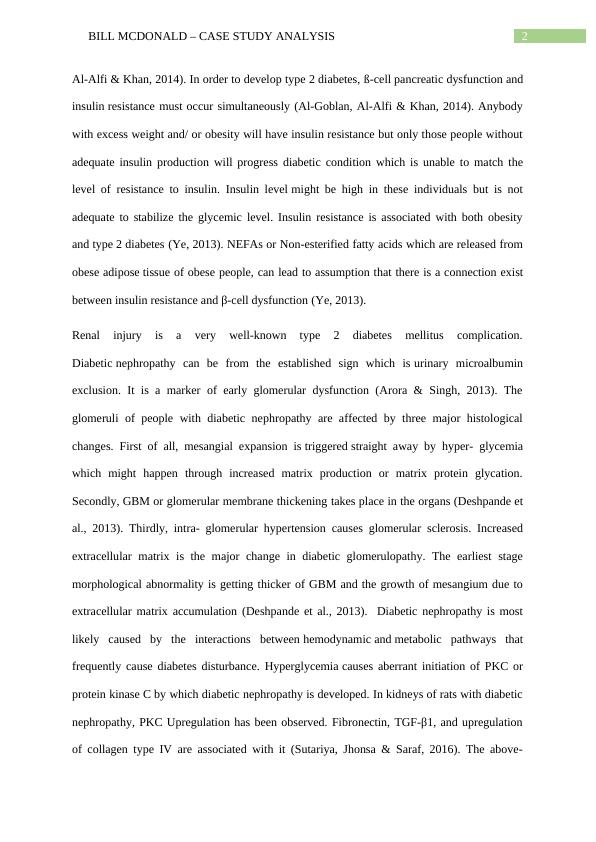Bill McDonald - Case Study Analysis
Added on 2023-01-23
10 Pages3094 Words54 Views
Running head: BILL MCDONALD – CASE STUDY ANALYSIS
BILL MCDONALD – CASE STUDY ANALYSIS
Name of the Student
Name of the University
Author’s Note:
BILL MCDONALD – CASE STUDY ANALYSIS
Name of the Student
Name of the University
Author’s Note:

1BILL MCDONALD – CASE STUDY ANALYSIS
Introduction:
The aim of this article is to deliver detailed analysis of the case study provided for Bill
McDonald. Three different scenarios were provided for this purpose and the chosen case
study for this article is the case study 1. Hence, question set A will be discussed for this
purpose with respect to the case study scenario 1. In this scenario, Bill McDonald is a fifty
eight year old male who has previously diagnosed with the type 2 diabetes. At the time
diagnosis, Mr McDonald was prescribed to take 500 mg metformin through oral dose but due
to ineffectiveness the dose was increased to 1000 mg for the last six months. From his latest
diagnosis, it has been reported that his HbA1c level is at 7.2 per cent. In addition to that, his
glucose level is also unstable and inconsistent over the last three months. He has a blood
pressure of 170/ 100 mm Hg with no symptoms but his eyes get tired very easily. In addition
to that, Mr McDonald had oedema in his feet. Furthermore, his urine analysis revealed the
presence of large amount of protein as well as decreased Glomerular Filtration rate. From this
case study, it can be seen that Mr McDonald is suffering from chronic diabetic symptoms like
hypertension, oedema, and diabetic nephropathy. Therefore, pathophysiology related to this
chronic symptoms will be discussed in the following sections as well as management
approaches and education plan for Mr McDonald.
Discussion:
Pathophysiology of type 2 diabetes with relation to the patient’s chronic symptoms: The
patho- physiology and mechanism of action of type 2 diabetes is different than that of type 1
diabetes. A combination of low levels of pancreatic β-cell secretion of insulin, and peripheral
insulin resistance can be used to describe type 2 diabetes. In plasma, insulin resistance results
in high fatty acids, triggering reduced transport of glucose into muscle cells and increased
breakdown of fat which in turn leads to enhanced production of hepatic glucose (Al-Goblan,
Introduction:
The aim of this article is to deliver detailed analysis of the case study provided for Bill
McDonald. Three different scenarios were provided for this purpose and the chosen case
study for this article is the case study 1. Hence, question set A will be discussed for this
purpose with respect to the case study scenario 1. In this scenario, Bill McDonald is a fifty
eight year old male who has previously diagnosed with the type 2 diabetes. At the time
diagnosis, Mr McDonald was prescribed to take 500 mg metformin through oral dose but due
to ineffectiveness the dose was increased to 1000 mg for the last six months. From his latest
diagnosis, it has been reported that his HbA1c level is at 7.2 per cent. In addition to that, his
glucose level is also unstable and inconsistent over the last three months. He has a blood
pressure of 170/ 100 mm Hg with no symptoms but his eyes get tired very easily. In addition
to that, Mr McDonald had oedema in his feet. Furthermore, his urine analysis revealed the
presence of large amount of protein as well as decreased Glomerular Filtration rate. From this
case study, it can be seen that Mr McDonald is suffering from chronic diabetic symptoms like
hypertension, oedema, and diabetic nephropathy. Therefore, pathophysiology related to this
chronic symptoms will be discussed in the following sections as well as management
approaches and education plan for Mr McDonald.
Discussion:
Pathophysiology of type 2 diabetes with relation to the patient’s chronic symptoms: The
patho- physiology and mechanism of action of type 2 diabetes is different than that of type 1
diabetes. A combination of low levels of pancreatic β-cell secretion of insulin, and peripheral
insulin resistance can be used to describe type 2 diabetes. In plasma, insulin resistance results
in high fatty acids, triggering reduced transport of glucose into muscle cells and increased
breakdown of fat which in turn leads to enhanced production of hepatic glucose (Al-Goblan,

2BILL MCDONALD – CASE STUDY ANALYSIS
Al-Alfi & Khan, 2014). In order to develop type 2 diabetes, ß-cell pancreatic dysfunction and
insulin resistance must occur simultaneously (Al-Goblan, Al-Alfi & Khan, 2014). Anybody
with excess weight and/ or obesity will have insulin resistance but only those people without
adequate insulin production will progress diabetic condition which is unable to match the
level of resistance to insulin. Insulin level might be high in these individuals but is not
adequate to stabilize the glycemic level. Insulin resistance is associated with both obesity
and type 2 diabetes (Ye, 2013). NEFAs or Non-esterified fatty acids which are released from
obese adipose tissue of obese people, can lead to assumption that there is a connection exist
between insulin resistance and β-cell dysfunction (Ye, 2013).
Renal injury is a very well-known type 2 diabetes mellitus complication.
Diabetic nephropathy can be from the established sign which is urinary microalbumin
exclusion. It is a marker of early glomerular dysfunction (Arora & Singh, 2013). The
glomeruli of people with diabetic nephropathy are affected by three major histological
changes. First of all, mesangial expansion is triggered straight away by hyper- glycemia
which might happen through increased matrix production or matrix protein glycation.
Secondly, GBM or glomerular membrane thickening takes place in the organs (Deshpande et
al., 2013). Thirdly, intra- glomerular hypertension causes glomerular sclerosis. Increased
extracellular matrix is the major change in diabetic glomerulopathy. The earliest stage
morphological abnormality is getting thicker of GBM and the growth of mesangium due to
extracellular matrix accumulation (Deshpande et al., 2013). Diabetic nephropathy is most
likely caused by the interactions between hemodynamic and metabolic pathways that
frequently cause diabetes disturbance. Hyperglycemia causes aberrant initiation of PKC or
protein kinase C by which diabetic nephropathy is developed. In kidneys of rats with diabetic
nephropathy, PKC Upregulation has been observed. Fibronectin, TGF-β1, and upregulation
of collagen type IV are associated with it (Sutariya, Jhonsa & Saraf, 2016). The above-
Al-Alfi & Khan, 2014). In order to develop type 2 diabetes, ß-cell pancreatic dysfunction and
insulin resistance must occur simultaneously (Al-Goblan, Al-Alfi & Khan, 2014). Anybody
with excess weight and/ or obesity will have insulin resistance but only those people without
adequate insulin production will progress diabetic condition which is unable to match the
level of resistance to insulin. Insulin level might be high in these individuals but is not
adequate to stabilize the glycemic level. Insulin resistance is associated with both obesity
and type 2 diabetes (Ye, 2013). NEFAs or Non-esterified fatty acids which are released from
obese adipose tissue of obese people, can lead to assumption that there is a connection exist
between insulin resistance and β-cell dysfunction (Ye, 2013).
Renal injury is a very well-known type 2 diabetes mellitus complication.
Diabetic nephropathy can be from the established sign which is urinary microalbumin
exclusion. It is a marker of early glomerular dysfunction (Arora & Singh, 2013). The
glomeruli of people with diabetic nephropathy are affected by three major histological
changes. First of all, mesangial expansion is triggered straight away by hyper- glycemia
which might happen through increased matrix production or matrix protein glycation.
Secondly, GBM or glomerular membrane thickening takes place in the organs (Deshpande et
al., 2013). Thirdly, intra- glomerular hypertension causes glomerular sclerosis. Increased
extracellular matrix is the major change in diabetic glomerulopathy. The earliest stage
morphological abnormality is getting thicker of GBM and the growth of mesangium due to
extracellular matrix accumulation (Deshpande et al., 2013). Diabetic nephropathy is most
likely caused by the interactions between hemodynamic and metabolic pathways that
frequently cause diabetes disturbance. Hyperglycemia causes aberrant initiation of PKC or
protein kinase C by which diabetic nephropathy is developed. In kidneys of rats with diabetic
nephropathy, PKC Upregulation has been observed. Fibronectin, TGF-β1, and upregulation
of collagen type IV are associated with it (Sutariya, Jhonsa & Saraf, 2016). The above-

End of preview
Want to access all the pages? Upload your documents or become a member.
Related Documents
Essay about the Nursing 2022lg...
|10
|2785
|26
The Relationship Between Obesity and Type 2 Diabetes Mellituslg...
|11
|2514
|471
Medical And Surgical Nursing Assignment 2022lg...
|11
|2796
|31
Management of Hypertensive Diabetic Patients: A Case Study of Bill McDonaldlg...
|11
|3034
|142
Pathophysiology of Type II Diabeteslg...
|10
|2810
|59
Diabetic Case Scenario: Pathophysiology, Causes, and Nursing Managementlg...
|9
|2775
|91
